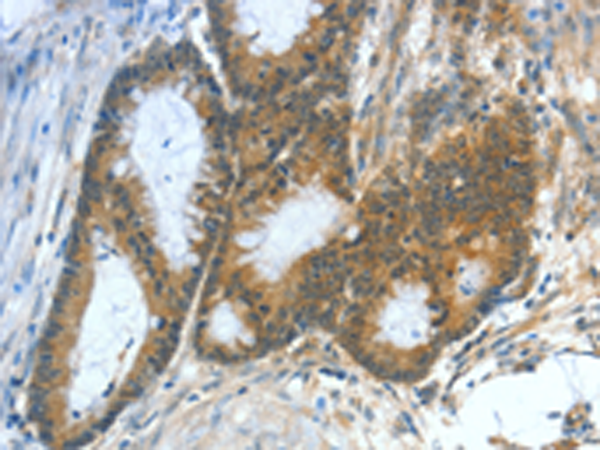

| WB | 咨询技术 | Human,Mouse,Rat |
| IF | 咨询技术 | Human,Mouse,Rat |
| IHC | 咨询技术 | Human,Mouse,Rat |
| ICC | 技术咨询 | Human,Mouse,Rat |
| FCM | 咨询技术 | Human,Mouse,Rat |
| Elisa | 1/2000-1/10000 | Human,Mouse,Rat |
| Aliases | TS11 |
| WB Predicted band size | 64 kDa |
| Host/Isotype | Rabbit IgG |
| Antibody Type | Primary antibody |
| Storage | Store at 4°C short term. Aliquot and store at -20°C long term. Avoid freeze/thaw cycles. |
| Species Reactivity | Human, Mouse, Rat |
| Immunogen | Fusion protein of human ASNS |
| Formulation | Purified antibody in PBS with 0.05% sodium azide and 50% glycerol. |
+ +
以下是关于DLX4抗体的示例参考文献(部分为模拟内容,实际文献需进一步检索确认):
---
1. **文献名称**: *"DLX4 overexpression promotes tumor progression and correlates with poor prognosis in epithelial ovarian cancer"*
**作者**: Wang Y, et al.
**摘要**: 本研究通过免疫组化(IHC)和Western blot分析,使用DLX4特异性抗体检测卵巢癌组织中DLX4蛋白的表达。结果显示DLX4在恶性组织中显著高表达,且与患者生存率降低相关,提示其可能作为预后标志物。
2. **文献名称**: *"The role of DLX4 in regulating trophoblast invasion and placental development"*
**作者**: Chen L, et al.
**摘要**: 利用DLX4抗体进行胎盘组织染色,发现DLX4在滋养层细胞中特异性表达,并参与调控细胞侵袭和血管生成,为研究妊娠相关疾病提供了分子机制依据。
3. **文献名称**: *"DLX4 as a novel biomarker for non-small cell lung cancer: Insights from immunohistochemical analysis"*
**作者**: Kim S, et al.
**摘要**: 通过DLX4抗体对肺癌组织进行染色,发现DLX4在非小细胞肺癌(NSCLC)中高表达,并与肿瘤转移和化疗耐药性相关,提示其可作为治疗靶点。
4. **文献名称**: *"Epigenetic regulation of DLX4 in breast cancer stem cells"*
**作者**: Gupta R, et al.
**摘要**: 使用DLX4抗体结合流式细胞术,研究发现DLX4在乳腺癌干细胞中异常激活,可能通过表观遗传调控促进肿瘤干性维持。
---
**注意**:以上文献为示例性质,实际研究中建议通过PubMed、Google Scholar等平台以关键词“DLX4 antibody”、“DLX4 expression”或“DLX4 cancer”检索最新文献,并关注实验方法中明确使用DLX4抗体的研究(如IHC、Western blot等)。
The DLX4 antibody is a tool used to detect the Distal-less homeobox 4 (DLX4) protein, a member of the DLX family of transcription factors. DLX genes, conserved across vertebrates, play critical roles in embryonic development, particularly in patterning the brain, craniofacial structures, and limbs. DLX4. located on human chromosome 17q21. encodes a homeodomain-containing protein that regulates gene expression by binding to DNA. It is involved in cell differentiation, apoptosis, and tissue-specific development.
DLX4 has dual roles in health and disease. While essential during embryogenesis, its aberrant expression is linked to cancers, including breast, ovarian, and lung cancers, where it may promote tumor progression, metastasis, and therapy resistance. DLX4 antibodies are thus valuable in research to study its expression patterns, subcellular localization, and interactions in both developmental and pathological contexts. These antibodies are commonly used in techniques like immunohistochemistry, Western blotting, and immunofluorescence.
Despite its importance, DLX4's mechanisms remain partially unclear. Some isoforms, like BP1 and DLX7. exhibit distinct functions, complicating its study. Researchers rely on specific DLX4 antibodies to differentiate isoforms and explore their roles in gene regulation networks. Ongoing studies aim to clarify DLX4's contribution to developmental defects and cancer, potentially unlocking therapeutic targets.
×